The Role of Customer Relationship Management in Business Success
VerifiedAdded on 2023/01/05
|12
|3403
|23
Essay
AI Summary
This essay provides a literature review exploring the critical role of Customer Relationship Management (CRM) in fostering customer satisfaction, with a specific focus on its application within the financial services sector. The review synthesizes various perspectives from different authors, emphasizing the importance of CRM in maintaining customer relationships, enhancing sales, and fulfilling customer needs. It delves into the impact of CRM on business operations, highlighting its benefits in understanding customer behavior, identifying profitable customer segments, and implementing effective marketing strategies. The essay also examines how CRM influences customer satisfaction through the integration of technology, processes, and people, leading to improved customer loyalty and increased market share. Furthermore, the essay identifies research gaps, suggesting areas for future investigation, such as a more in-depth analysis of CRM strategies and the advantages and disadvantages of its implementation.
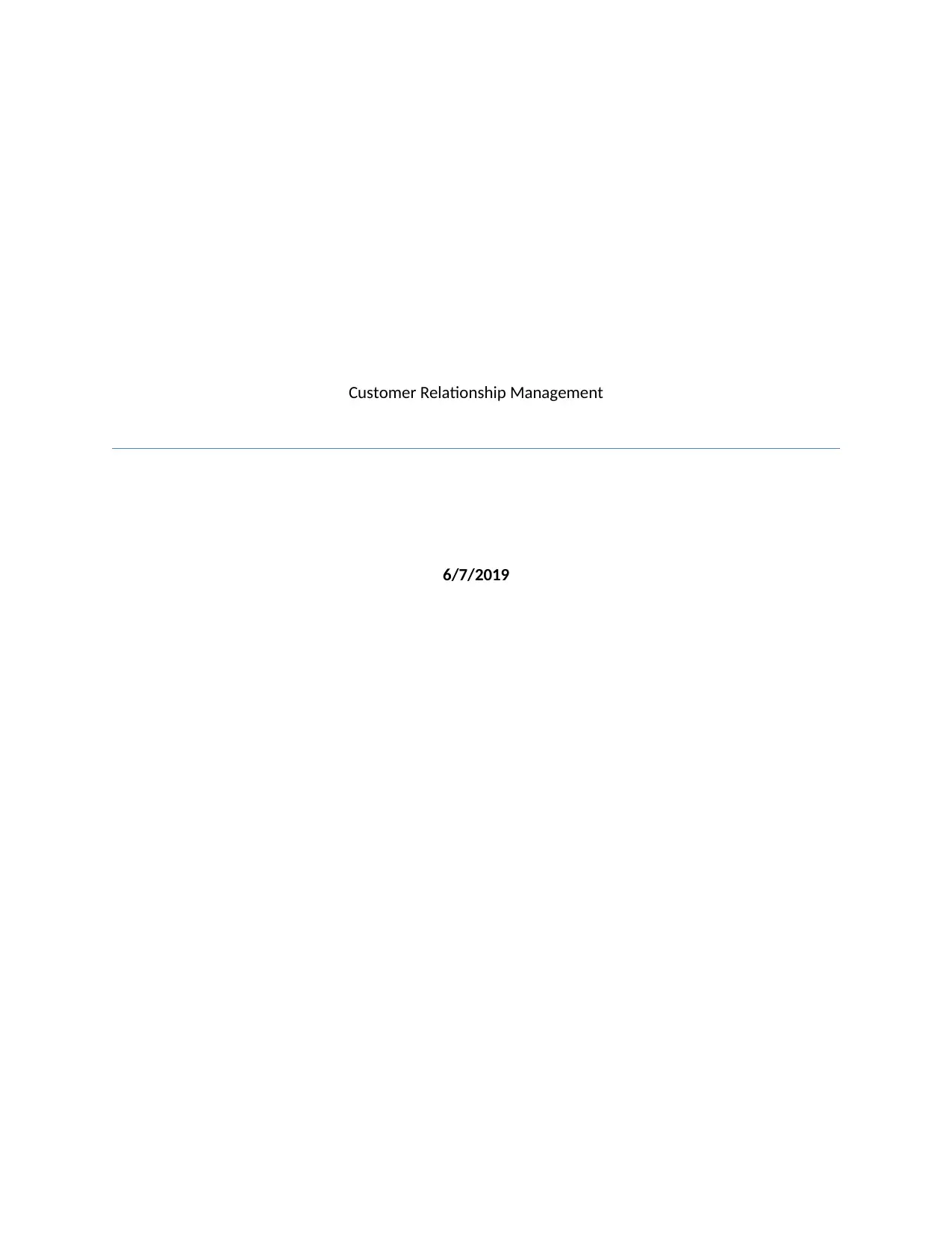
Customer Relationship Management
6/7/2019
6/7/2019
Paraphrase This Document
Need a fresh take? Get an instant paraphrase of this document with our AI Paraphraser
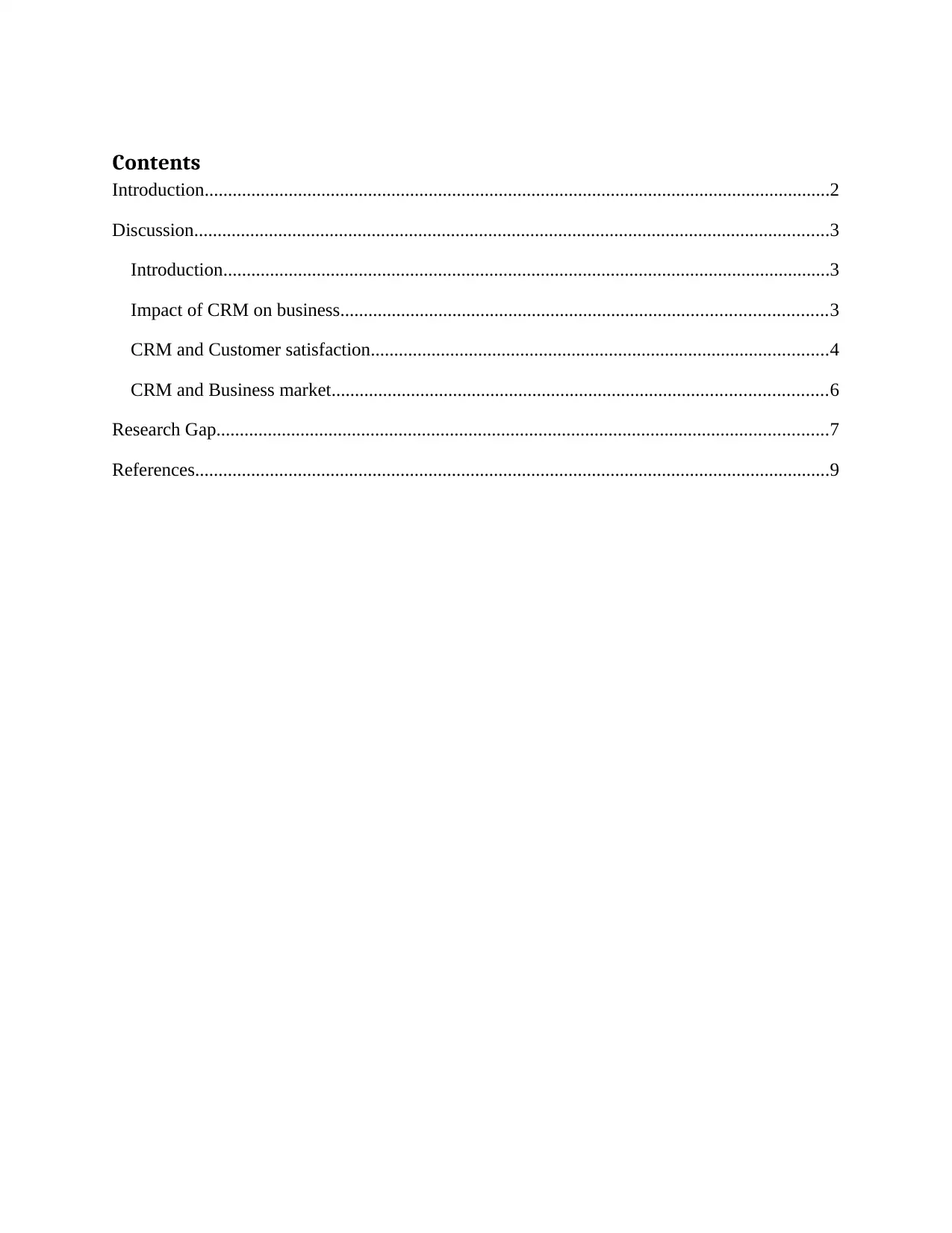
Contents
Introduction......................................................................................................................................2
Discussion........................................................................................................................................3
Introduction..................................................................................................................................3
Impact of CRM on business........................................................................................................3
CRM and Customer satisfaction..................................................................................................4
CRM and Business market..........................................................................................................6
Research Gap...................................................................................................................................7
References........................................................................................................................................9
Introduction......................................................................................................................................2
Discussion........................................................................................................................................3
Introduction..................................................................................................................................3
Impact of CRM on business........................................................................................................3
CRM and Customer satisfaction..................................................................................................4
CRM and Business market..........................................................................................................6
Research Gap...................................................................................................................................7
References........................................................................................................................................9
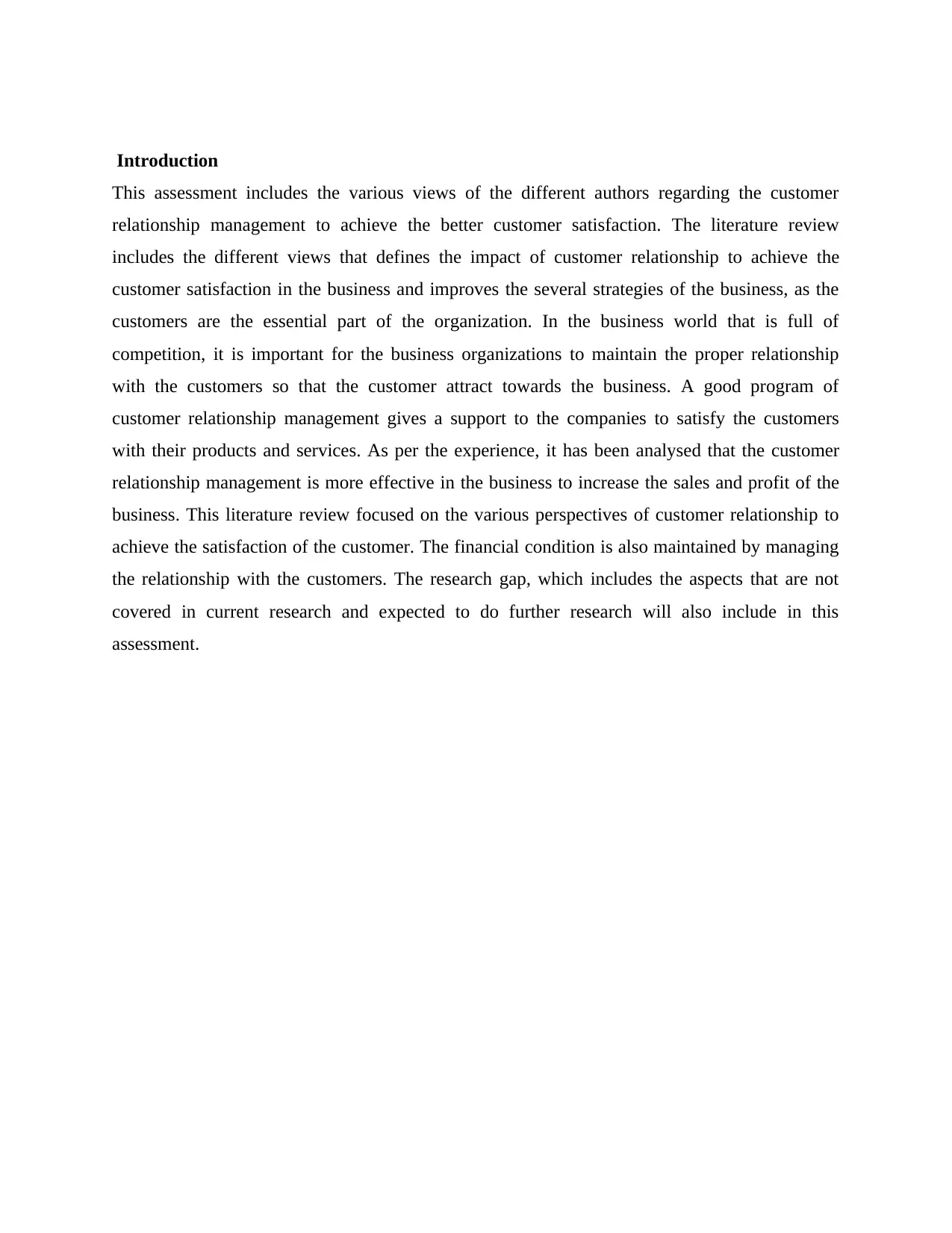
Introduction
This assessment includes the various views of the different authors regarding the customer
relationship management to achieve the better customer satisfaction. The literature review
includes the different views that defines the impact of customer relationship to achieve the
customer satisfaction in the business and improves the several strategies of the business, as the
customers are the essential part of the organization. In the business world that is full of
competition, it is important for the business organizations to maintain the proper relationship
with the customers so that the customer attract towards the business. A good program of
customer relationship management gives a support to the companies to satisfy the customers
with their products and services. As per the experience, it has been analysed that the customer
relationship management is more effective in the business to increase the sales and profit of the
business. This literature review focused on the various perspectives of customer relationship to
achieve the satisfaction of the customer. The financial condition is also maintained by managing
the relationship with the customers. The research gap, which includes the aspects that are not
covered in current research and expected to do further research will also include in this
assessment.
This assessment includes the various views of the different authors regarding the customer
relationship management to achieve the better customer satisfaction. The literature review
includes the different views that defines the impact of customer relationship to achieve the
customer satisfaction in the business and improves the several strategies of the business, as the
customers are the essential part of the organization. In the business world that is full of
competition, it is important for the business organizations to maintain the proper relationship
with the customers so that the customer attract towards the business. A good program of
customer relationship management gives a support to the companies to satisfy the customers
with their products and services. As per the experience, it has been analysed that the customer
relationship management is more effective in the business to increase the sales and profit of the
business. This literature review focused on the various perspectives of customer relationship to
achieve the satisfaction of the customer. The financial condition is also maintained by managing
the relationship with the customers. The research gap, which includes the aspects that are not
covered in current research and expected to do further research will also include in this
assessment.
⊘ This is a preview!⊘
Do you want full access?
Subscribe today to unlock all pages.

Trusted by 1+ million students worldwide
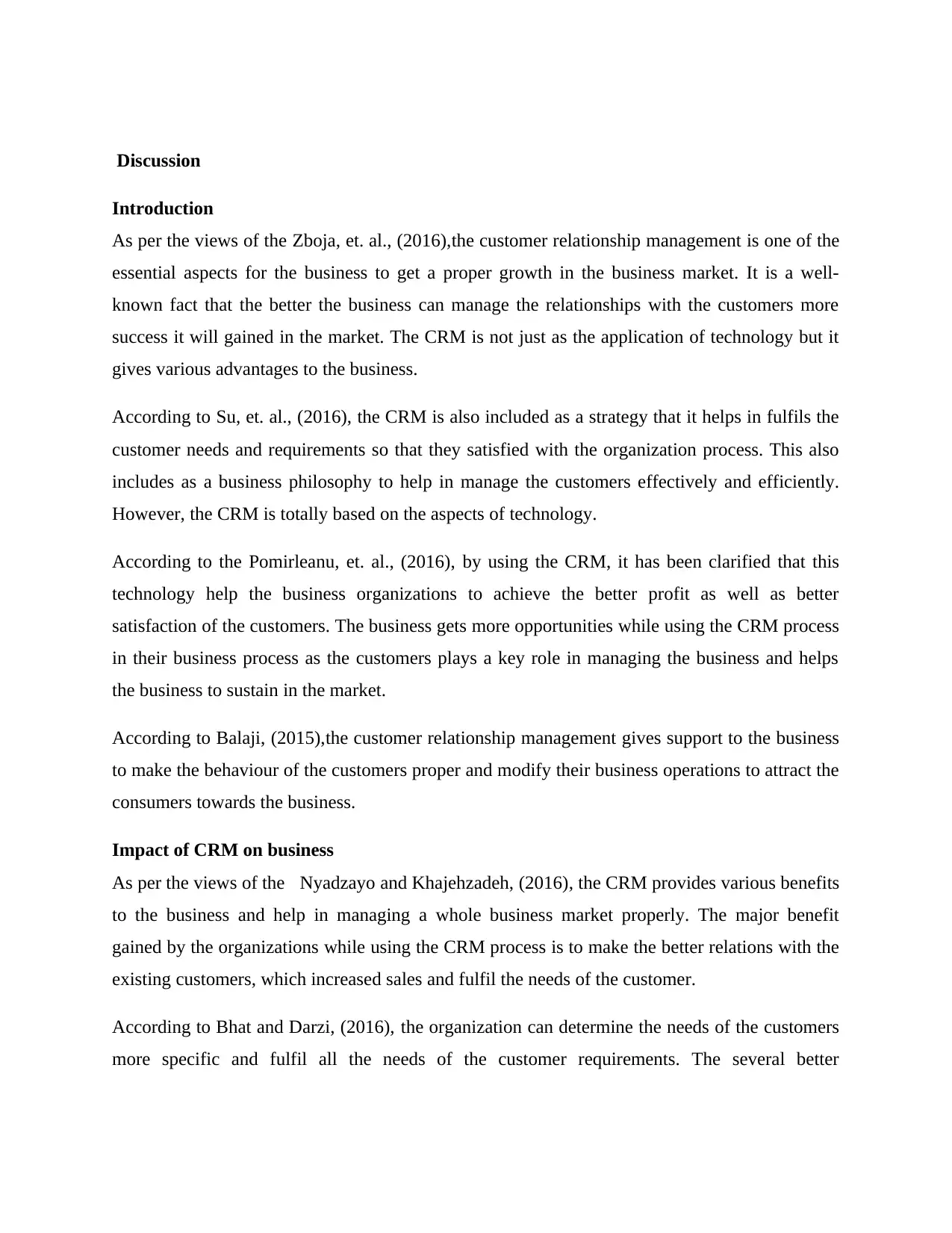
Discussion
Introduction
As per the views of the Zboja, et. al., (2016),the customer relationship management is one of the
essential aspects for the business to get a proper growth in the business market. It is a well-
known fact that the better the business can manage the relationships with the customers more
success it will gained in the market. The CRM is not just as the application of technology but it
gives various advantages to the business.
According to Su, et. al., (2016), the CRM is also included as a strategy that it helps in fulfils the
customer needs and requirements so that they satisfied with the organization process. This also
includes as a business philosophy to help in manage the customers effectively and efficiently.
However, the CRM is totally based on the aspects of technology.
According to the Pomirleanu, et. al., (2016), by using the CRM, it has been clarified that this
technology help the business organizations to achieve the better profit as well as better
satisfaction of the customers. The business gets more opportunities while using the CRM process
in their business process as the customers plays a key role in managing the business and helps
the business to sustain in the market.
According to Balaji, (2015),the customer relationship management gives support to the business
to make the behaviour of the customers proper and modify their business operations to attract the
consumers towards the business.
Impact of CRM on business
As per the views of the Nyadzayo and Khajehzadeh, (2016), the CRM provides various benefits
to the business and help in managing a whole business market properly. The major benefit
gained by the organizations while using the CRM process is to make the better relations with the
existing customers, which increased sales and fulfil the needs of the customer.
According to Bhat and Darzi, (2016), the organization can determine the needs of the customers
more specific and fulfil all the needs of the customer requirements. The several better
Introduction
As per the views of the Zboja, et. al., (2016),the customer relationship management is one of the
essential aspects for the business to get a proper growth in the business market. It is a well-
known fact that the better the business can manage the relationships with the customers more
success it will gained in the market. The CRM is not just as the application of technology but it
gives various advantages to the business.
According to Su, et. al., (2016), the CRM is also included as a strategy that it helps in fulfils the
customer needs and requirements so that they satisfied with the organization process. This also
includes as a business philosophy to help in manage the customers effectively and efficiently.
However, the CRM is totally based on the aspects of technology.
According to the Pomirleanu, et. al., (2016), by using the CRM, it has been clarified that this
technology help the business organizations to achieve the better profit as well as better
satisfaction of the customers. The business gets more opportunities while using the CRM process
in their business process as the customers plays a key role in managing the business and helps
the business to sustain in the market.
According to Balaji, (2015),the customer relationship management gives support to the business
to make the behaviour of the customers proper and modify their business operations to attract the
consumers towards the business.
Impact of CRM on business
As per the views of the Nyadzayo and Khajehzadeh, (2016), the CRM provides various benefits
to the business and help in managing a whole business market properly. The major benefit
gained by the organizations while using the CRM process is to make the better relations with the
existing customers, which increased sales and fulfil the needs of the customer.
According to Bhat and Darzi, (2016), the organization can determine the needs of the customers
more specific and fulfil all the needs of the customer requirements. The several better
Paraphrase This Document
Need a fresh take? Get an instant paraphrase of this document with our AI Paraphraser
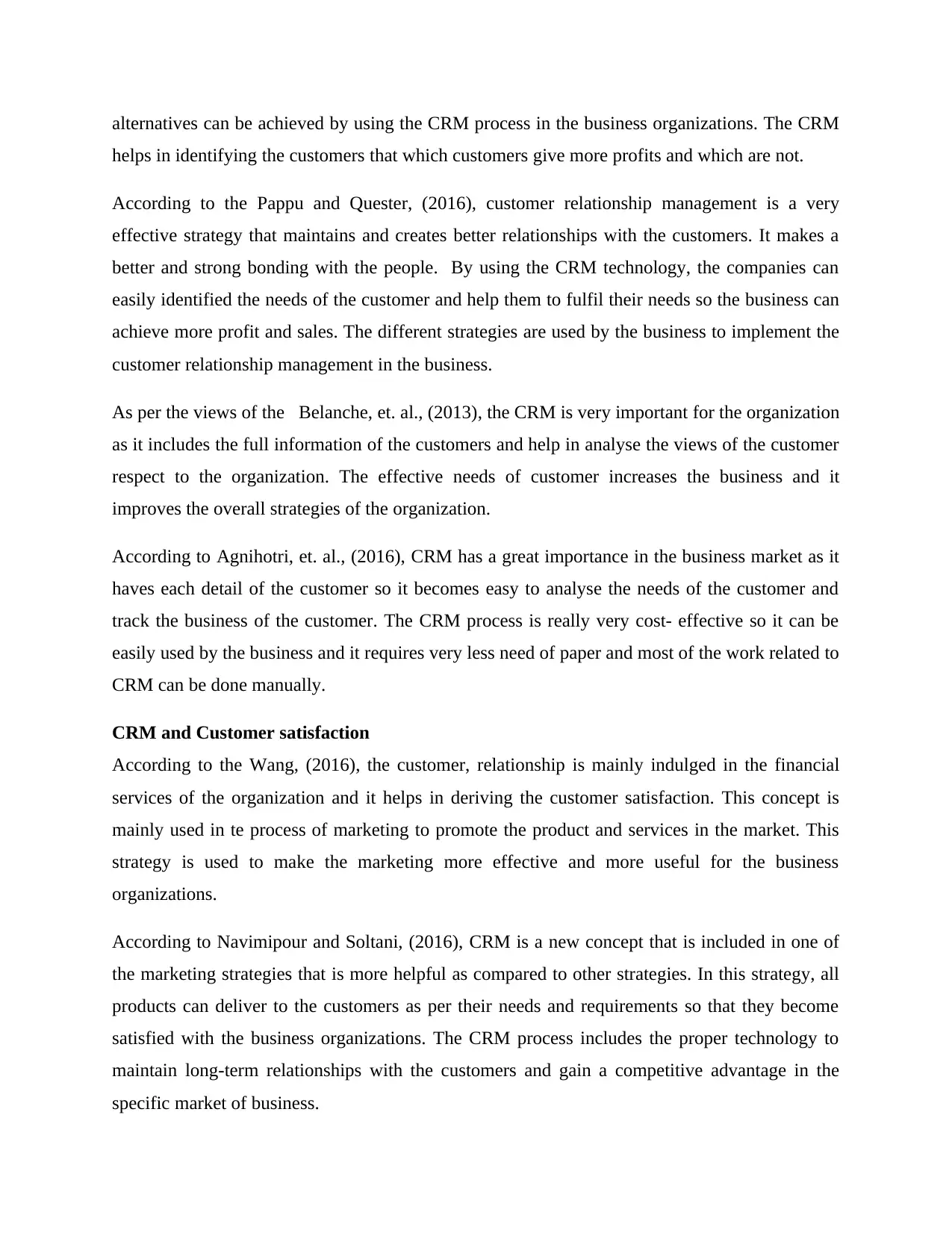
alternatives can be achieved by using the CRM process in the business organizations. The CRM
helps in identifying the customers that which customers give more profits and which are not.
According to the Pappu and Quester, (2016), customer relationship management is a very
effective strategy that maintains and creates better relationships with the customers. It makes a
better and strong bonding with the people. By using the CRM technology, the companies can
easily identified the needs of the customer and help them to fulfil their needs so the business can
achieve more profit and sales. The different strategies are used by the business to implement the
customer relationship management in the business.
As per the views of the Belanche, et. al., (2013), the CRM is very important for the organization
as it includes the full information of the customers and help in analyse the views of the customer
respect to the organization. The effective needs of customer increases the business and it
improves the overall strategies of the organization.
According to Agnihotri, et. al., (2016), CRM has a great importance in the business market as it
haves each detail of the customer so it becomes easy to analyse the needs of the customer and
track the business of the customer. The CRM process is really very cost- effective so it can be
easily used by the business and it requires very less need of paper and most of the work related to
CRM can be done manually.
CRM and Customer satisfaction
According to the Wang, (2016), the customer, relationship is mainly indulged in the financial
services of the organization and it helps in deriving the customer satisfaction. This concept is
mainly used in te process of marketing to promote the product and services in the market. This
strategy is used to make the marketing more effective and more useful for the business
organizations.
According to Navimipour and Soltani, (2016), CRM is a new concept that is included in one of
the marketing strategies that is more helpful as compared to other strategies. In this strategy, all
products can deliver to the customers as per their needs and requirements so that they become
satisfied with the business organizations. The CRM process includes the proper technology to
maintain long-term relationships with the customers and gain a competitive advantage in the
specific market of business.
helps in identifying the customers that which customers give more profits and which are not.
According to the Pappu and Quester, (2016), customer relationship management is a very
effective strategy that maintains and creates better relationships with the customers. It makes a
better and strong bonding with the people. By using the CRM technology, the companies can
easily identified the needs of the customer and help them to fulfil their needs so the business can
achieve more profit and sales. The different strategies are used by the business to implement the
customer relationship management in the business.
As per the views of the Belanche, et. al., (2013), the CRM is very important for the organization
as it includes the full information of the customers and help in analyse the views of the customer
respect to the organization. The effective needs of customer increases the business and it
improves the overall strategies of the organization.
According to Agnihotri, et. al., (2016), CRM has a great importance in the business market as it
haves each detail of the customer so it becomes easy to analyse the needs of the customer and
track the business of the customer. The CRM process is really very cost- effective so it can be
easily used by the business and it requires very less need of paper and most of the work related to
CRM can be done manually.
CRM and Customer satisfaction
According to the Wang, (2016), the customer, relationship is mainly indulged in the financial
services of the organization and it helps in deriving the customer satisfaction. This concept is
mainly used in te process of marketing to promote the product and services in the market. This
strategy is used to make the marketing more effective and more useful for the business
organizations.
According to Navimipour and Soltani, (2016), CRM is a new concept that is included in one of
the marketing strategies that is more helpful as compared to other strategies. In this strategy, all
products can deliver to the customers as per their needs and requirements so that they become
satisfied with the business organizations. The CRM process includes the proper technology to
maintain long-term relationships with the customers and gain a competitive advantage in the
specific market of business.
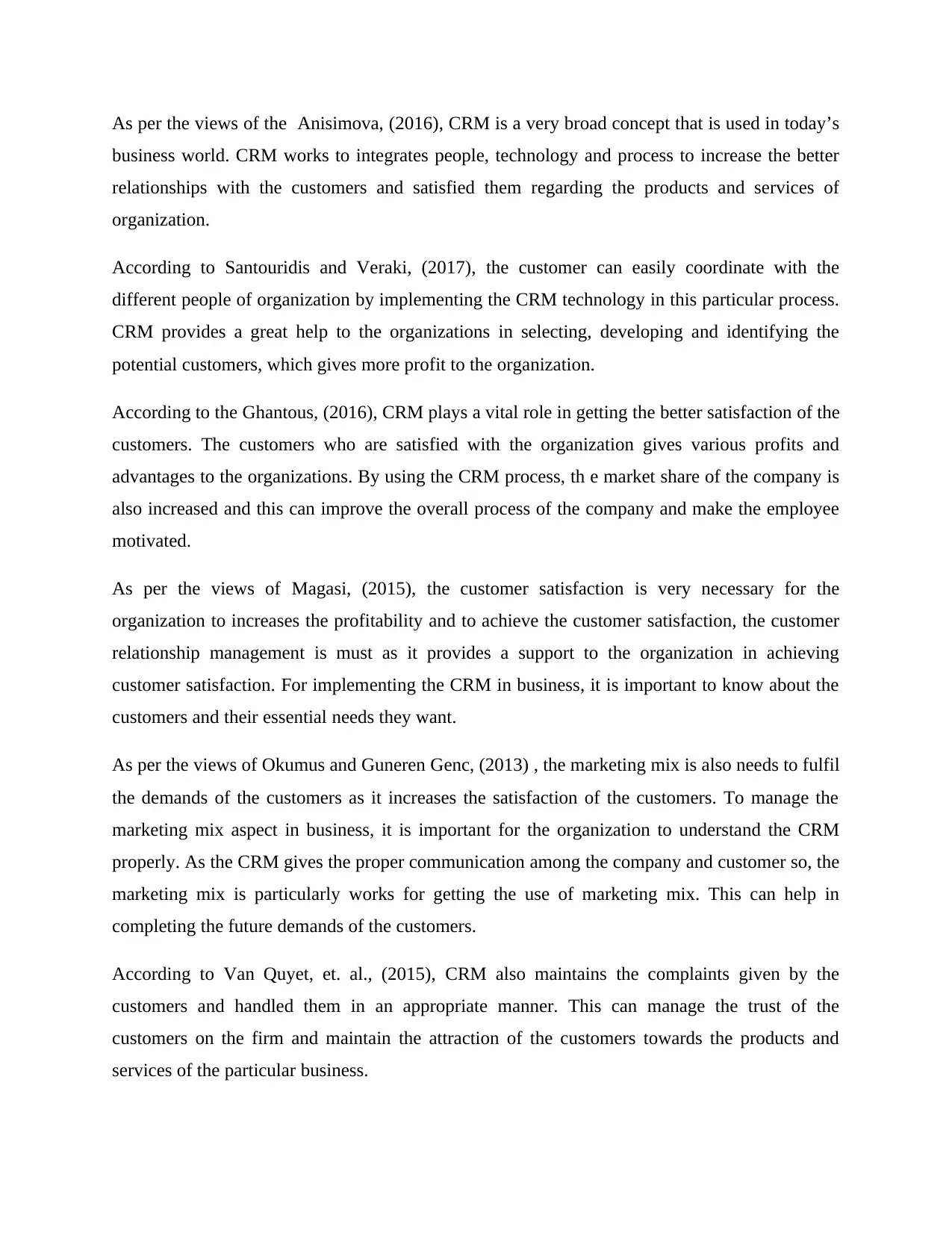
As per the views of the Anisimova, (2016), CRM is a very broad concept that is used in today’s
business world. CRM works to integrates people, technology and process to increase the better
relationships with the customers and satisfied them regarding the products and services of
organization.
According to Santouridis and Veraki, (2017), the customer can easily coordinate with the
different people of organization by implementing the CRM technology in this particular process.
CRM provides a great help to the organizations in selecting, developing and identifying the
potential customers, which gives more profit to the organization.
According to the Ghantous, (2016), CRM plays a vital role in getting the better satisfaction of the
customers. The customers who are satisfied with the organization gives various profits and
advantages to the organizations. By using the CRM process, th e market share of the company is
also increased and this can improve the overall process of the company and make the employee
motivated.
As per the views of Magasi, (2015), the customer satisfaction is very necessary for the
organization to increases the profitability and to achieve the customer satisfaction, the customer
relationship management is must as it provides a support to the organization in achieving
customer satisfaction. For implementing the CRM in business, it is important to know about the
customers and their essential needs they want.
As per the views of Okumus and Guneren Genc, (2013) , the marketing mix is also needs to fulfil
the demands of the customers as it increases the satisfaction of the customers. To manage the
marketing mix aspect in business, it is important for the organization to understand the CRM
properly. As the CRM gives the proper communication among the company and customer so, the
marketing mix is particularly works for getting the use of marketing mix. This can help in
completing the future demands of the customers.
According to Van Quyet, et. al., (2015), CRM also maintains the complaints given by the
customers and handled them in an appropriate manner. This can manage the trust of the
customers on the firm and maintain the attraction of the customers towards the products and
services of the particular business.
business world. CRM works to integrates people, technology and process to increase the better
relationships with the customers and satisfied them regarding the products and services of
organization.
According to Santouridis and Veraki, (2017), the customer can easily coordinate with the
different people of organization by implementing the CRM technology in this particular process.
CRM provides a great help to the organizations in selecting, developing and identifying the
potential customers, which gives more profit to the organization.
According to the Ghantous, (2016), CRM plays a vital role in getting the better satisfaction of the
customers. The customers who are satisfied with the organization gives various profits and
advantages to the organizations. By using the CRM process, th e market share of the company is
also increased and this can improve the overall process of the company and make the employee
motivated.
As per the views of Magasi, (2015), the customer satisfaction is very necessary for the
organization to increases the profitability and to achieve the customer satisfaction, the customer
relationship management is must as it provides a support to the organization in achieving
customer satisfaction. For implementing the CRM in business, it is important to know about the
customers and their essential needs they want.
As per the views of Okumus and Guneren Genc, (2013) , the marketing mix is also needs to fulfil
the demands of the customers as it increases the satisfaction of the customers. To manage the
marketing mix aspect in business, it is important for the organization to understand the CRM
properly. As the CRM gives the proper communication among the company and customer so, the
marketing mix is particularly works for getting the use of marketing mix. This can help in
completing the future demands of the customers.
According to Van Quyet, et. al., (2015), CRM also maintains the complaints given by the
customers and handled them in an appropriate manner. This can manage the trust of the
customers on the firm and maintain the attraction of the customers towards the products and
services of the particular business.
⊘ This is a preview!⊘
Do you want full access?
Subscribe today to unlock all pages.

Trusted by 1+ million students worldwide
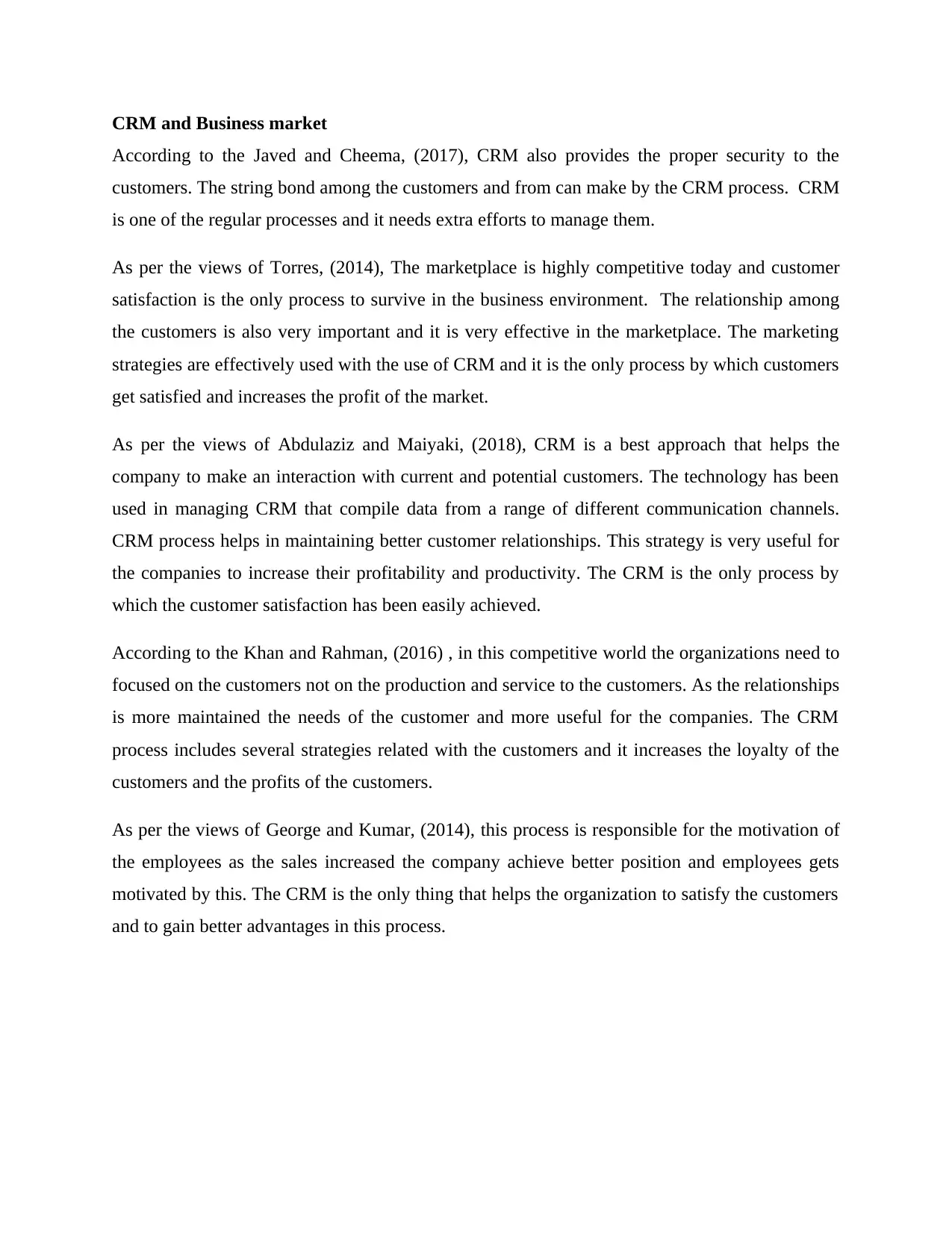
CRM and Business market
According to the Javed and Cheema, (2017), CRM also provides the proper security to the
customers. The string bond among the customers and from can make by the CRM process. CRM
is one of the regular processes and it needs extra efforts to manage them.
As per the views of Torres, (2014), The marketplace is highly competitive today and customer
satisfaction is the only process to survive in the business environment. The relationship among
the customers is also very important and it is very effective in the marketplace. The marketing
strategies are effectively used with the use of CRM and it is the only process by which customers
get satisfied and increases the profit of the market.
As per the views of Abdulaziz and Maiyaki, (2018), CRM is a best approach that helps the
company to make an interaction with current and potential customers. The technology has been
used in managing CRM that compile data from a range of different communication channels.
CRM process helps in maintaining better customer relationships. This strategy is very useful for
the companies to increase their profitability and productivity. The CRM is the only process by
which the customer satisfaction has been easily achieved.
According to the Khan and Rahman, (2016) , in this competitive world the organizations need to
focused on the customers not on the production and service to the customers. As the relationships
is more maintained the needs of the customer and more useful for the companies. The CRM
process includes several strategies related with the customers and it increases the loyalty of the
customers and the profits of the customers.
As per the views of George and Kumar, (2014), this process is responsible for the motivation of
the employees as the sales increased the company achieve better position and employees gets
motivated by this. The CRM is the only thing that helps the organization to satisfy the customers
and to gain better advantages in this process.
According to the Javed and Cheema, (2017), CRM also provides the proper security to the
customers. The string bond among the customers and from can make by the CRM process. CRM
is one of the regular processes and it needs extra efforts to manage them.
As per the views of Torres, (2014), The marketplace is highly competitive today and customer
satisfaction is the only process to survive in the business environment. The relationship among
the customers is also very important and it is very effective in the marketplace. The marketing
strategies are effectively used with the use of CRM and it is the only process by which customers
get satisfied and increases the profit of the market.
As per the views of Abdulaziz and Maiyaki, (2018), CRM is a best approach that helps the
company to make an interaction with current and potential customers. The technology has been
used in managing CRM that compile data from a range of different communication channels.
CRM process helps in maintaining better customer relationships. This strategy is very useful for
the companies to increase their profitability and productivity. The CRM is the only process by
which the customer satisfaction has been easily achieved.
According to the Khan and Rahman, (2016) , in this competitive world the organizations need to
focused on the customers not on the production and service to the customers. As the relationships
is more maintained the needs of the customer and more useful for the companies. The CRM
process includes several strategies related with the customers and it increases the loyalty of the
customers and the profits of the customers.
As per the views of George and Kumar, (2014), this process is responsible for the motivation of
the employees as the sales increased the company achieve better position and employees gets
motivated by this. The CRM is the only thing that helps the organization to satisfy the customers
and to gain better advantages in this process.
Paraphrase This Document
Need a fresh take? Get an instant paraphrase of this document with our AI Paraphraser
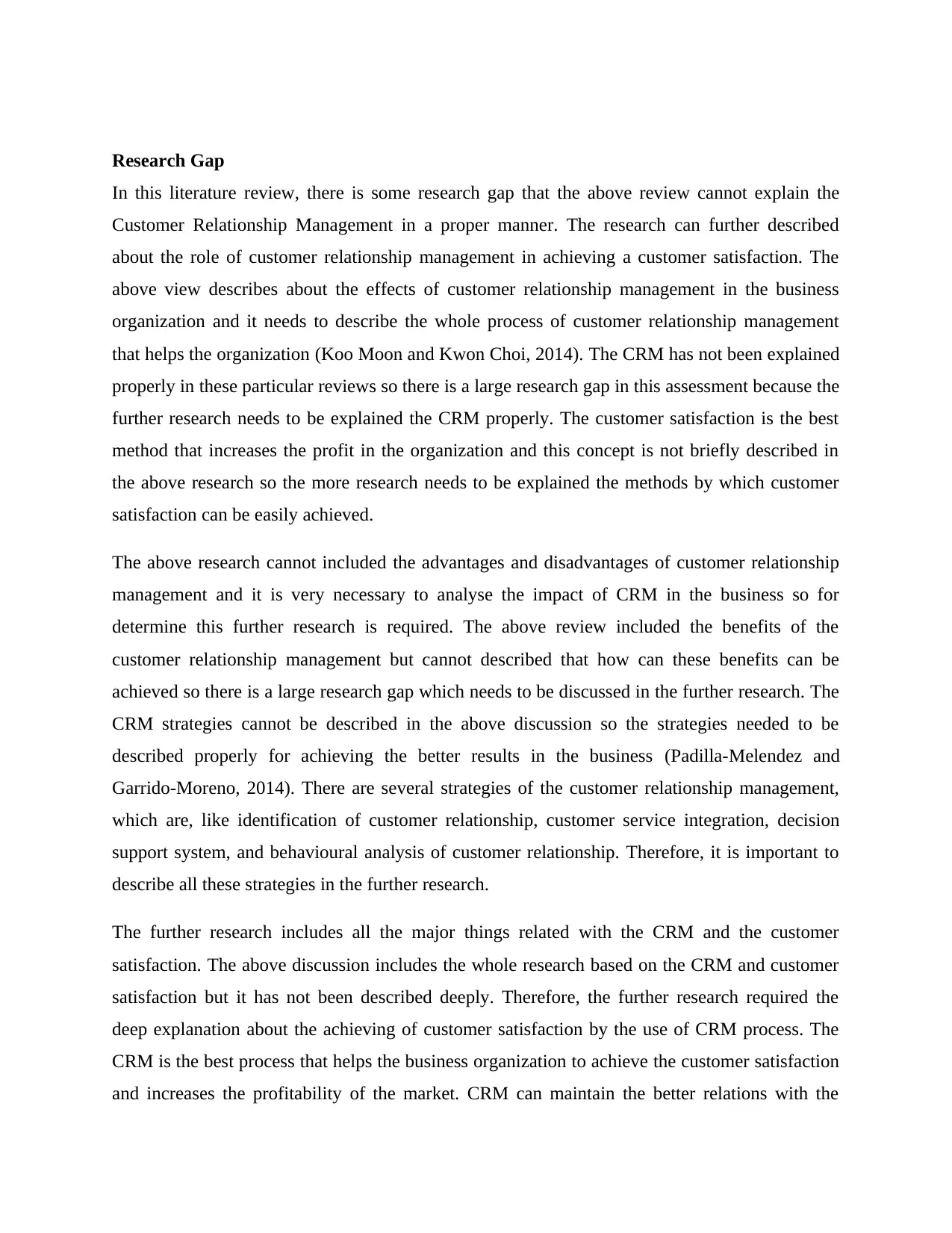
Research Gap
In this literature review, there is some research gap that the above review cannot explain the
Customer Relationship Management in a proper manner. The research can further described
about the role of customer relationship management in achieving a customer satisfaction. The
above view describes about the effects of customer relationship management in the business
organization and it needs to describe the whole process of customer relationship management
that helps the organization (Koo Moon and Kwon Choi, 2014). The CRM has not been explained
properly in these particular reviews so there is a large research gap in this assessment because the
further research needs to be explained the CRM properly. The customer satisfaction is the best
method that increases the profit in the organization and this concept is not briefly described in
the above research so the more research needs to be explained the methods by which customer
satisfaction can be easily achieved.
The above research cannot included the advantages and disadvantages of customer relationship
management and it is very necessary to analyse the impact of CRM in the business so for
determine this further research is required. The above review included the benefits of the
customer relationship management but cannot described that how can these benefits can be
achieved so there is a large research gap which needs to be discussed in the further research. The
CRM strategies cannot be described in the above discussion so the strategies needed to be
described properly for achieving the better results in the business (Padilla-Melendez and
Garrido-Moreno, 2014). There are several strategies of the customer relationship management,
which are, like identification of customer relationship, customer service integration, decision
support system, and behavioural analysis of customer relationship. Therefore, it is important to
describe all these strategies in the further research.
The further research includes all the major things related with the CRM and the customer
satisfaction. The above discussion includes the whole research based on the CRM and customer
satisfaction but it has not been described deeply. Therefore, the further research required the
deep explanation about the achieving of customer satisfaction by the use of CRM process. The
CRM is the best process that helps the business organization to achieve the customer satisfaction
and increases the profitability of the market. CRM can maintain the better relations with the
In this literature review, there is some research gap that the above review cannot explain the
Customer Relationship Management in a proper manner. The research can further described
about the role of customer relationship management in achieving a customer satisfaction. The
above view describes about the effects of customer relationship management in the business
organization and it needs to describe the whole process of customer relationship management
that helps the organization (Koo Moon and Kwon Choi, 2014). The CRM has not been explained
properly in these particular reviews so there is a large research gap in this assessment because the
further research needs to be explained the CRM properly. The customer satisfaction is the best
method that increases the profit in the organization and this concept is not briefly described in
the above research so the more research needs to be explained the methods by which customer
satisfaction can be easily achieved.
The above research cannot included the advantages and disadvantages of customer relationship
management and it is very necessary to analyse the impact of CRM in the business so for
determine this further research is required. The above review included the benefits of the
customer relationship management but cannot described that how can these benefits can be
achieved so there is a large research gap which needs to be discussed in the further research. The
CRM strategies cannot be described in the above discussion so the strategies needed to be
described properly for achieving the better results in the business (Padilla-Melendez and
Garrido-Moreno, 2014). There are several strategies of the customer relationship management,
which are, like identification of customer relationship, customer service integration, decision
support system, and behavioural analysis of customer relationship. Therefore, it is important to
describe all these strategies in the further research.
The further research includes all the major things related with the CRM and the customer
satisfaction. The above discussion includes the whole research based on the CRM and customer
satisfaction but it has not been described deeply. Therefore, the further research required the
deep explanation about the achieving of customer satisfaction by the use of CRM process. The
CRM is the best process that helps the business organization to achieve the customer satisfaction
and increases the profitability of the market. CRM can maintain the better relations with the
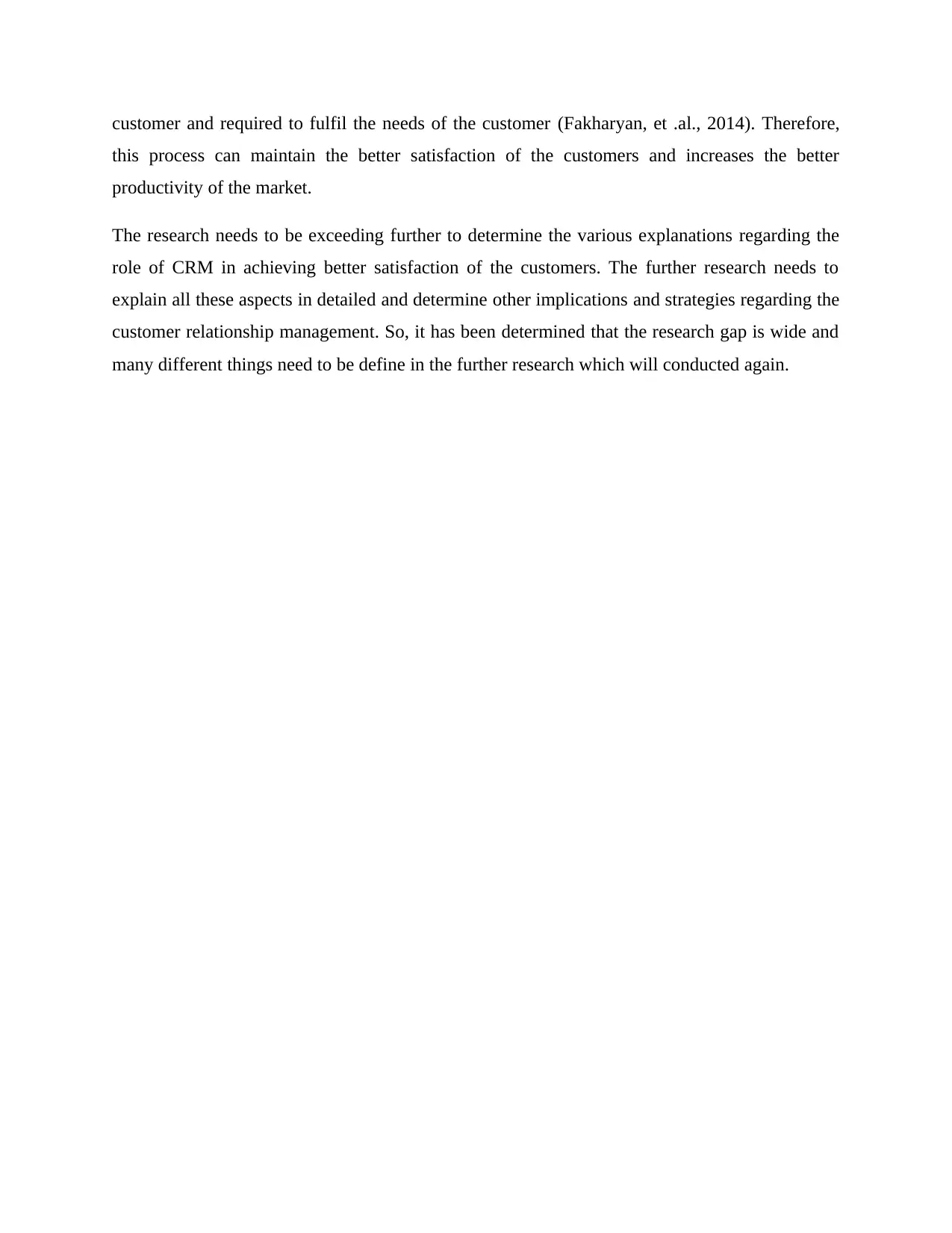
customer and required to fulfil the needs of the customer (Fakharyan, et .al., 2014). Therefore,
this process can maintain the better satisfaction of the customers and increases the better
productivity of the market.
The research needs to be exceeding further to determine the various explanations regarding the
role of CRM in achieving better satisfaction of the customers. The further research needs to
explain all these aspects in detailed and determine other implications and strategies regarding the
customer relationship management. So, it has been determined that the research gap is wide and
many different things need to be define in the further research which will conducted again.
this process can maintain the better satisfaction of the customers and increases the better
productivity of the market.
The research needs to be exceeding further to determine the various explanations regarding the
role of CRM in achieving better satisfaction of the customers. The further research needs to
explain all these aspects in detailed and determine other implications and strategies regarding the
customer relationship management. So, it has been determined that the research gap is wide and
many different things need to be define in the further research which will conducted again.
⊘ This is a preview!⊘
Do you want full access?
Subscribe today to unlock all pages.

Trusted by 1+ million students worldwide
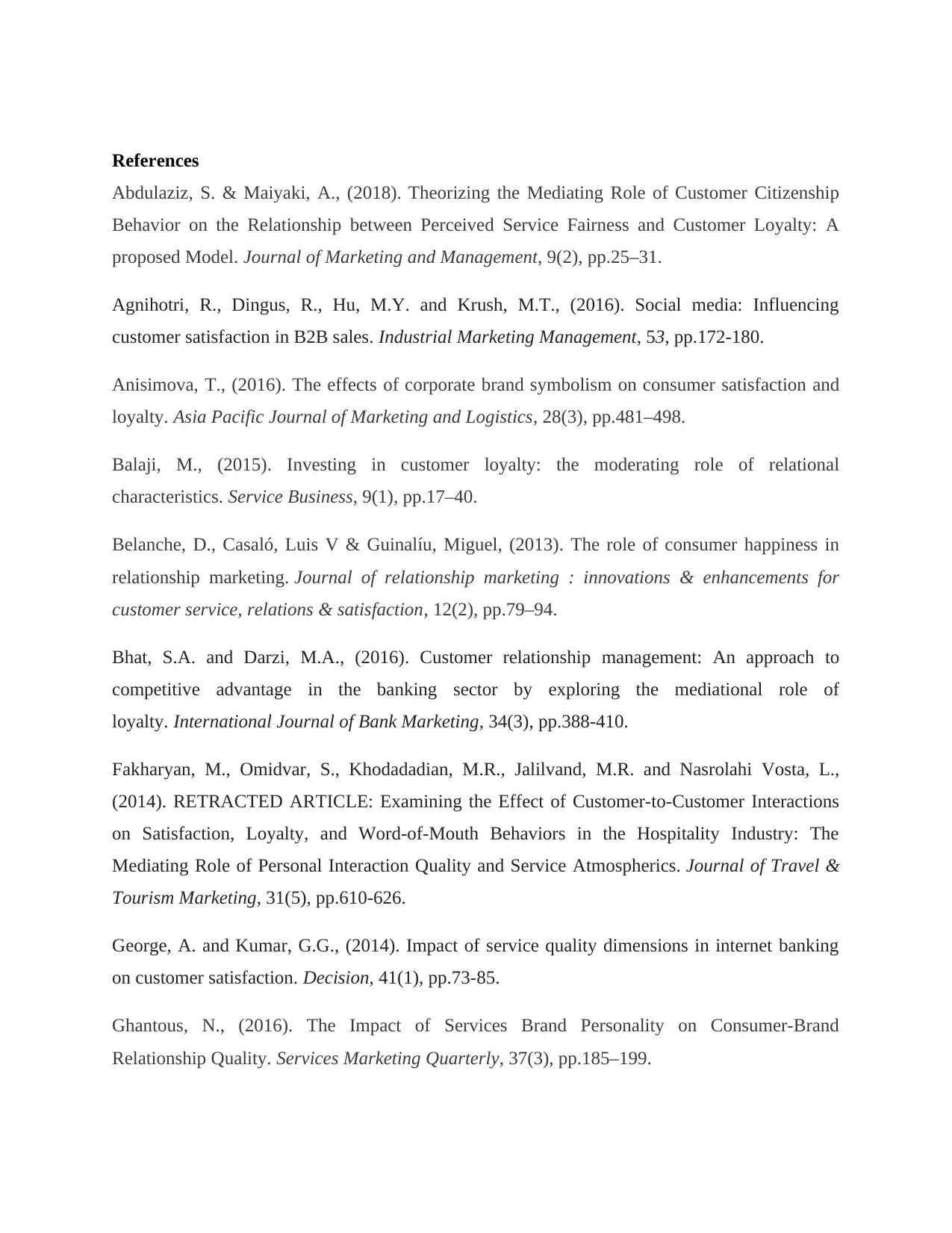
References
Abdulaziz, S. & Maiyaki, A., (2018). Theorizing the Mediating Role of Customer Citizenship
Behavior on the Relationship between Perceived Service Fairness and Customer Loyalty: A
proposed Model. Journal of Marketing and Management, 9(2), pp.25–31.
Agnihotri, R., Dingus, R., Hu, M.Y. and Krush, M.T., (2016). Social media: Influencing
customer satisfaction in B2B sales. Industrial Marketing Management, 53, pp.172-180.
Anisimova, T., (2016). The effects of corporate brand symbolism on consumer satisfaction and
loyalty. Asia Pacific Journal of Marketing and Logistics, 28(3), pp.481–498.
Balaji, M., (2015). Investing in customer loyalty: the moderating role of relational
characteristics. Service Business, 9(1), pp.17–40.
Belanche, D., Casaló, Luis V & Guinalíu, Miguel, (2013). The role of consumer happiness in
relationship marketing. Journal of relationship marketing : innovations & enhancements for
customer service, relations & satisfaction, 12(2), pp.79–94.
Bhat, S.A. and Darzi, M.A., (2016). Customer relationship management: An approach to
competitive advantage in the banking sector by exploring the mediational role of
loyalty. International Journal of Bank Marketing, 34(3), pp.388-410.
Fakharyan, M., Omidvar, S., Khodadadian, M.R., Jalilvand, M.R. and Nasrolahi Vosta, L.,
(2014). RETRACTED ARTICLE: Examining the Effect of Customer-to-Customer Interactions
on Satisfaction, Loyalty, and Word-of-Mouth Behaviors in the Hospitality Industry: The
Mediating Role of Personal Interaction Quality and Service Atmospherics. Journal of Travel &
Tourism Marketing, 31(5), pp.610-626.
George, A. and Kumar, G.G., (2014). Impact of service quality dimensions in internet banking
on customer satisfaction. Decision, 41(1), pp.73-85.
Ghantous, N., (2016). The Impact of Services Brand Personality on Consumer-Brand
Relationship Quality. Services Marketing Quarterly, 37(3), pp.185–199.
Abdulaziz, S. & Maiyaki, A., (2018). Theorizing the Mediating Role of Customer Citizenship
Behavior on the Relationship between Perceived Service Fairness and Customer Loyalty: A
proposed Model. Journal of Marketing and Management, 9(2), pp.25–31.
Agnihotri, R., Dingus, R., Hu, M.Y. and Krush, M.T., (2016). Social media: Influencing
customer satisfaction in B2B sales. Industrial Marketing Management, 53, pp.172-180.
Anisimova, T., (2016). The effects of corporate brand symbolism on consumer satisfaction and
loyalty. Asia Pacific Journal of Marketing and Logistics, 28(3), pp.481–498.
Balaji, M., (2015). Investing in customer loyalty: the moderating role of relational
characteristics. Service Business, 9(1), pp.17–40.
Belanche, D., Casaló, Luis V & Guinalíu, Miguel, (2013). The role of consumer happiness in
relationship marketing. Journal of relationship marketing : innovations & enhancements for
customer service, relations & satisfaction, 12(2), pp.79–94.
Bhat, S.A. and Darzi, M.A., (2016). Customer relationship management: An approach to
competitive advantage in the banking sector by exploring the mediational role of
loyalty. International Journal of Bank Marketing, 34(3), pp.388-410.
Fakharyan, M., Omidvar, S., Khodadadian, M.R., Jalilvand, M.R. and Nasrolahi Vosta, L.,
(2014). RETRACTED ARTICLE: Examining the Effect of Customer-to-Customer Interactions
on Satisfaction, Loyalty, and Word-of-Mouth Behaviors in the Hospitality Industry: The
Mediating Role of Personal Interaction Quality and Service Atmospherics. Journal of Travel &
Tourism Marketing, 31(5), pp.610-626.
George, A. and Kumar, G.G., (2014). Impact of service quality dimensions in internet banking
on customer satisfaction. Decision, 41(1), pp.73-85.
Ghantous, N., (2016). The Impact of Services Brand Personality on Consumer-Brand
Relationship Quality. Services Marketing Quarterly, 37(3), pp.185–199.
Paraphrase This Document
Need a fresh take? Get an instant paraphrase of this document with our AI Paraphraser
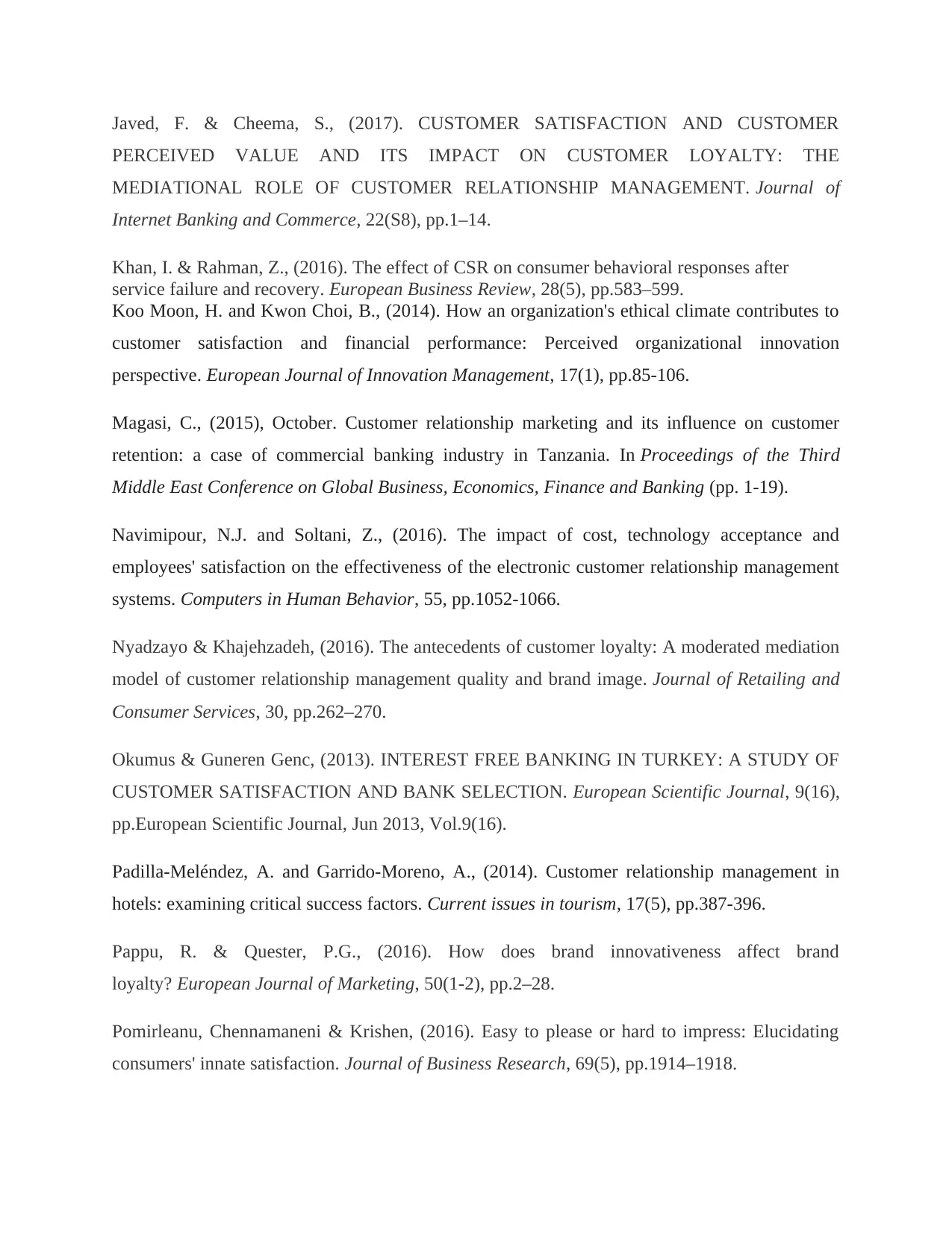
Javed, F. & Cheema, S., (2017). CUSTOMER SATISFACTION AND CUSTOMER
PERCEIVED VALUE AND ITS IMPACT ON CUSTOMER LOYALTY: THE
MEDIATIONAL ROLE OF CUSTOMER RELATIONSHIP MANAGEMENT. Journal of
Internet Banking and Commerce, 22(S8), pp.1–14.
Khan, I. & Rahman, Z., (2016). The effect of CSR on consumer behavioral responses after
service failure and recovery. European Business Review, 28(5), pp.583–599.
Koo Moon, H. and Kwon Choi, B., (2014). How an organization's ethical climate contributes to
customer satisfaction and financial performance: Perceived organizational innovation
perspective. European Journal of Innovation Management, 17(1), pp.85-106.
Magasi, C., (2015), October. Customer relationship marketing and its influence on customer
retention: a case of commercial banking industry in Tanzania. In Proceedings of the Third
Middle East Conference on Global Business, Economics, Finance and Banking (pp. 1-19).
Navimipour, N.J. and Soltani, Z., (2016). The impact of cost, technology acceptance and
employees' satisfaction on the effectiveness of the electronic customer relationship management
systems. Computers in Human Behavior, 55, pp.1052-1066.
Nyadzayo & Khajehzadeh, (2016). The antecedents of customer loyalty: A moderated mediation
model of customer relationship management quality and brand image. Journal of Retailing and
Consumer Services, 30, pp.262–270.
Okumus & Guneren Genc, (2013). INTEREST FREE BANKING IN TURKEY: A STUDY OF
CUSTOMER SATISFACTION AND BANK SELECTION. European Scientific Journal, 9(16),
pp.European Scientific Journal, Jun 2013, Vol.9(16).
Padilla-Meléndez, A. and Garrido-Moreno, A., (2014). Customer relationship management in
hotels: examining critical success factors. Current issues in tourism, 17(5), pp.387-396.
Pappu, R. & Quester, P.G., (2016). How does brand innovativeness affect brand
loyalty? European Journal of Marketing, 50(1-2), pp.2–28.
Pomirleanu, Chennamaneni & Krishen, (2016). Easy to please or hard to impress: Elucidating
consumers' innate satisfaction. Journal of Business Research, 69(5), pp.1914–1918.
PERCEIVED VALUE AND ITS IMPACT ON CUSTOMER LOYALTY: THE
MEDIATIONAL ROLE OF CUSTOMER RELATIONSHIP MANAGEMENT. Journal of
Internet Banking and Commerce, 22(S8), pp.1–14.
Khan, I. & Rahman, Z., (2016). The effect of CSR on consumer behavioral responses after
service failure and recovery. European Business Review, 28(5), pp.583–599.
Koo Moon, H. and Kwon Choi, B., (2014). How an organization's ethical climate contributes to
customer satisfaction and financial performance: Perceived organizational innovation
perspective. European Journal of Innovation Management, 17(1), pp.85-106.
Magasi, C., (2015), October. Customer relationship marketing and its influence on customer
retention: a case of commercial banking industry in Tanzania. In Proceedings of the Third
Middle East Conference on Global Business, Economics, Finance and Banking (pp. 1-19).
Navimipour, N.J. and Soltani, Z., (2016). The impact of cost, technology acceptance and
employees' satisfaction on the effectiveness of the electronic customer relationship management
systems. Computers in Human Behavior, 55, pp.1052-1066.
Nyadzayo & Khajehzadeh, (2016). The antecedents of customer loyalty: A moderated mediation
model of customer relationship management quality and brand image. Journal of Retailing and
Consumer Services, 30, pp.262–270.
Okumus & Guneren Genc, (2013). INTEREST FREE BANKING IN TURKEY: A STUDY OF
CUSTOMER SATISFACTION AND BANK SELECTION. European Scientific Journal, 9(16),
pp.European Scientific Journal, Jun 2013, Vol.9(16).
Padilla-Meléndez, A. and Garrido-Moreno, A., (2014). Customer relationship management in
hotels: examining critical success factors. Current issues in tourism, 17(5), pp.387-396.
Pappu, R. & Quester, P.G., (2016). How does brand innovativeness affect brand
loyalty? European Journal of Marketing, 50(1-2), pp.2–28.
Pomirleanu, Chennamaneni & Krishen, (2016). Easy to please or hard to impress: Elucidating
consumers' innate satisfaction. Journal of Business Research, 69(5), pp.1914–1918.
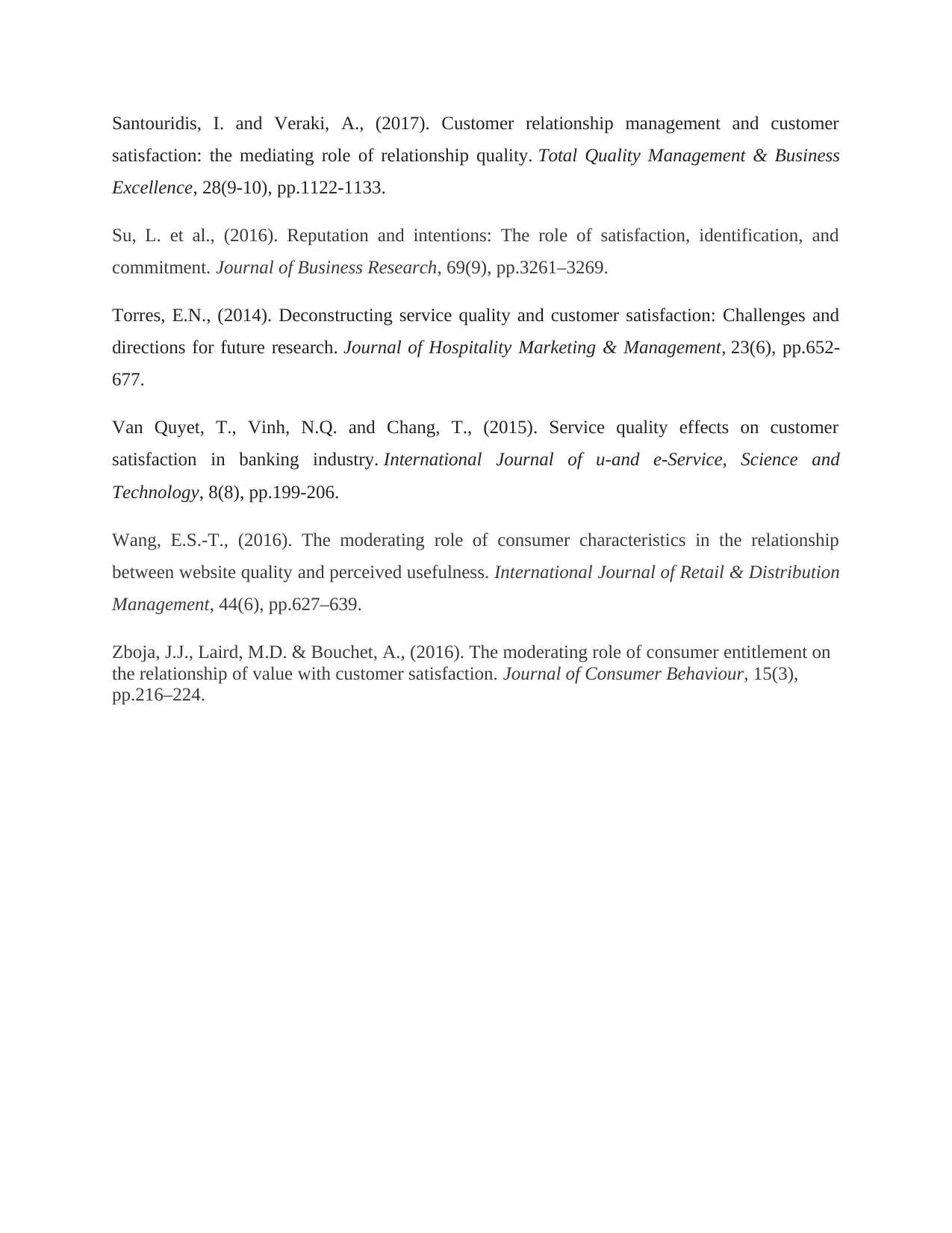
Santouridis, I. and Veraki, A., (2017). Customer relationship management and customer
satisfaction: the mediating role of relationship quality. Total Quality Management & Business
Excellence, 28(9-10), pp.1122-1133.
Su, L. et al., (2016). Reputation and intentions: The role of satisfaction, identification, and
commitment. Journal of Business Research, 69(9), pp.3261–3269.
Torres, E.N., (2014). Deconstructing service quality and customer satisfaction: Challenges and
directions for future research. Journal of Hospitality Marketing & Management, 23(6), pp.652-
677.
Van Quyet, T., Vinh, N.Q. and Chang, T., (2015). Service quality effects on customer
satisfaction in banking industry. International Journal of u-and e-Service, Science and
Technology, 8(8), pp.199-206.
Wang, E.S.-T., (2016). The moderating role of consumer characteristics in the relationship
between website quality and perceived usefulness. International Journal of Retail & Distribution
Management, 44(6), pp.627–639.
Zboja, J.J., Laird, M.D. & Bouchet, A., (2016). The moderating role of consumer entitlement on
the relationship of value with customer satisfaction. Journal of Consumer Behaviour, 15(3),
pp.216–224.
satisfaction: the mediating role of relationship quality. Total Quality Management & Business
Excellence, 28(9-10), pp.1122-1133.
Su, L. et al., (2016). Reputation and intentions: The role of satisfaction, identification, and
commitment. Journal of Business Research, 69(9), pp.3261–3269.
Torres, E.N., (2014). Deconstructing service quality and customer satisfaction: Challenges and
directions for future research. Journal of Hospitality Marketing & Management, 23(6), pp.652-
677.
Van Quyet, T., Vinh, N.Q. and Chang, T., (2015). Service quality effects on customer
satisfaction in banking industry. International Journal of u-and e-Service, Science and
Technology, 8(8), pp.199-206.
Wang, E.S.-T., (2016). The moderating role of consumer characteristics in the relationship
between website quality and perceived usefulness. International Journal of Retail & Distribution
Management, 44(6), pp.627–639.
Zboja, J.J., Laird, M.D. & Bouchet, A., (2016). The moderating role of consumer entitlement on
the relationship of value with customer satisfaction. Journal of Consumer Behaviour, 15(3),
pp.216–224.
⊘ This is a preview!⊘
Do you want full access?
Subscribe today to unlock all pages.

Trusted by 1+ million students worldwide
1 out of 12
Related Documents
Your All-in-One AI-Powered Toolkit for Academic Success.
+13062052269
info@desklib.com
Available 24*7 on WhatsApp / Email
![[object Object]](/_next/static/media/star-bottom.7253800d.svg)
Unlock your academic potential
Copyright © 2020–2025 A2Z Services. All Rights Reserved. Developed and managed by ZUCOL.




